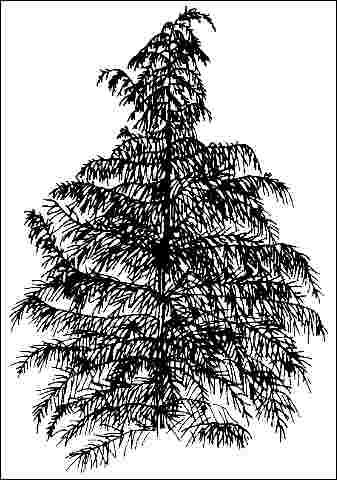Cedrus deodara 'Kashmir': 'Kashmir' Deodar Cedar
Introduction
With its pyramidal shape, soft silver-blue needles and drooping branches, this cedar cultivar makes a graceful specimen or accent tree. It has better cold hardiness than the species. Growing rapidly to 40 to 50 feet tall and 20 to 30 feet wide, it also works well as a soft screen. The trunk stays fairly straight with lateral branches nearly horizontal and drooping. Lower branches should be left on the tree so the true form of the tree can show. Allow plenty of room for these to spread. They are best located as a lawn specimen away from walks, streets, and sidewalks so branches will not have to be pruned. Large specimens have trunks almost three feet in diameter.

General Information
Scientific name: Cedrus deodara
Pronunciation: SEE-drus dee-oh-DAR-uh
Common name(s): 'Kashmir' deodar cedar
Family: Pinaceae
USDA hardiness zones: 6A through 8B (Figure 2)
Origin: not native to North America
Invasive potential: not assessed/incomplete assessment
Uses: specimen; screen; street without sidewalk; tree lawn > 6 ft wide; highway median

Description
Height: 40 to 60 feet
Spread: 20 to 30 feet
Crown uniformity: symmetrical
Crown shape: pyramidal
Crown density: moderate
Growth rate: fast
Texture: fine
Foliage
Leaf arrangement: spiral (Figure 3)
Leaf type: simple
Leaf margin: entire
Leaf shape: needle-like (filiform)
Leaf venation: parallel
Leaf type and persistence: evergreen, needled evergreen
Leaf blade length: less than 2 inches
Leaf color: silver
Fall color: no color change
Fall characteristic: not showy

Flower
Flower color: unknown
Flower characteristics: not showy
Fruit
Fruit shape: oval, cone
Fruit length: 3 to 6 inches
Fruit covering: dry or hard
Fruit color: brown
Fruit characteristics: does not attract wildlife; showy; fruit/leaves not a litter problem
Trunk and Branches
Trunk/bark/branches: branches droop; not showy; typically one trunk; thorns
Pruning requirement: little required
Breakage: resistant
Current year twig color: green, brown
Current year twig thickness: medium
Wood specific gravity: unknown
Culture
Light requirement: full sun
Soil tolerances: sand; loam; clay; acidic; slightly alkaline; well-drained
Drought tolerance: high
Aerosol salt tolerance: unknown
Other
Roots: not a problem
Winter interest: no
Outstanding tree: yes
Ozone sensitivity: unknown
Verticillium wilt susceptibility: resistant
Pest resistance: resistant to pests/diseases
Use and Management
The species has been successfully used as a street or median planting with lower branches removed. It appears to tolerate compacted, poor soil but declines in areas where smog is a problem. Plant on 20-foot-centers to create a canopy of blue foliage over a small residential street. This is probably the best true cedar for the South.
Transplants easily if root-pruned or from a container and protected from sweeping winds. It does well in dry, sunny spots and will tolerate high pH and clay soil. Cold-damaged trees die back at the top.
There are some other attractive cultivars: 'Aurea'—yellow leaves (looks ill); 'Pendula'—long, drooping leaves; 'Robusta'—stiffer twigs.
Pests and Diseases
No pests or diseases are of major concern. Scales, borers, deodar weevils, and bagworms may be an issue. Following a cold winter, tops often decline and dieback. Secondary fungi can sometimes be associated with this decline.



